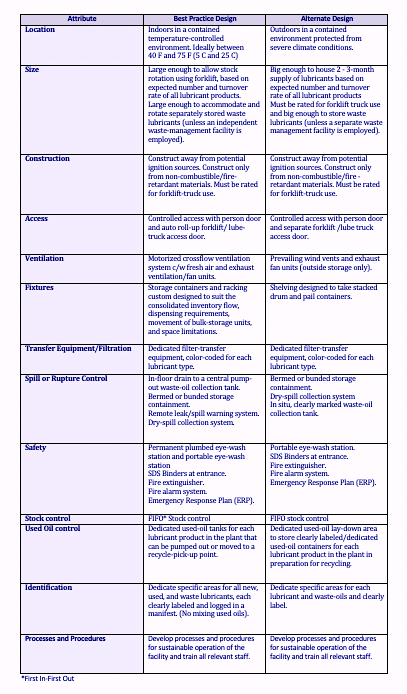Part 1 of this article regarding a cradle-to-cradle approach to lubricant management (Jan. 30, 2022, see link below) laid out a blueprint for understanding and documenting a site’s lubricant current state. This blueprint is used to build a crucial lubricant-consolidation audit/program and then design, prepare, and operate a world-class lubricant storage/dispensing area.
Click Here To Read Part 1 Of This Article
“Document Your Current State”
With a consolidated-lubricant list in place, specifications for the storage/dispensing area can be developed. To ensure the facility can accommodate the plant’s lubricant needs, these details must be verified:
♦ number of different lubricant products to be carried, stored, and dispensed
♦ anticipated usage amounts for each lubricant (information that’s used to recommend the most economical purchase method and storage-container size, as well as determine the following needs):
-
- real-estate requirements for a 3-to-6-month supply of each lubricant (2 to 3 inventory-turn
cycles per year) to ensure fresh product is always available for use - type and amount of filtering, dispensing, and transfer equipment to ensure only
contamination-free lubricants end up in bearing-surface areas.
- real-estate requirements for a 3-to-6-month supply of each lubricant (2 to 3 inventory-turn
♦ in-plant geography of where each lubricant is to be used (information used to determine economical lube routes and logistical requirements, e., number of lubrication technicians required, lube truck, forklift, lubricant-delivery equipment for getting the right lubricant(s) to the right machine(s).
♦ SDS (Safety Data Sheets) for all lubricants to determine the storage and handling requirements, as well as the safety equipment required.
Table I (below) lists the typical attributes of a storage and dispensing facility that must be factored into the design. Best practices, as well as reasonable design alternatives are shown.
 Table I. Lubricant Storage Facility Design Criteria.
Table I. Lubricant Storage Facility Design Criteria.
(Courtesy Engtech Industries Inc.)
LOCATION/SIZE
As with any real estate, a good location is paramount for a lubricant storage and handling facility (and logistically important for receiving lubricants and dispatching them throughout the plant). Large plants may require controlled satellite locations. Equally important is the ability to protect virgin stock lubricants from the outside elements. Extreme temperatures (hot and cold) and large temperature swings promote moisture condensation in containers. Wind and rain bring the risk of solids and water contamination if lubricant containers aren’t stored and/or handled with care prior to opening for lubricant transfer.
All locations must be rated for and large enough to allow forklift and lube-truck traffic to operate within and around its confines. Temperature- and humidity-controlled indoor locations are preferred and must be large enough to house enough inventory to ensure the lubricant is always fresh and available. Ideal locations allow for bulk delivery and recycle-truck access.
VENTILATION
Because lubricants can discharge vapors that might be harmful if allowed to accumulate, a good, motorized-fan crossflow ventilation system consisting of fresh-air units and exhaust-fan units is required for all indoor facilities.
Enclosed outdoor facilities may require similar crossflow ventilation, if the building cannot take advantage of prevailing-wind vents open to air (vents should be filtered using a furnace-style filter) complimented with exhaust-fan units.
FIXTURES
Based on the lubricant turnover rate and storage-container economics, storage and handling facilities may accommodate a variety of containment devices that may include:
♦ 300-gallon poly totes for bulk oil distribution
♦ custom, color-coded steel tank bulk-oil storage and dispensing units/systems
♦ drum racks designed to take palletized drums in the upright position, or drum-dispensing racks set on “bunded” (spill-control platforms/catchment trays) with the drum positioned on its side in the rack, complete with a dispensing/metering valve system
♦ pails for lesser-used lubricants, stacked on bunded pallets similar to stacked drums.
TRANSFER/FILTRATION EQUIPMENT
To move lubricants to machines, maintenance personnel must transfer them from one container to another in the most non-contaminable way possible.
For bulk containers, use of dedicated transfer/filter cart style dispensing units will ensure lubricant is moved from bulk and pre-packaged supplier containers to the machine reservoirs and/or dedicated closed-pour containers for transfer to lube-system reservoirs.
SPILL CONTROL
Best practice is to slope storage-room floors to a low-point drain, where spilled product can be collected into an easily accessible common waste tank for removal. Spilled lubricants can also be captured within a bermed-capture area on the floor, or in a bunded-capture spill tray.
In most countries and U.S. states, mixed used oil and all spilled oil is to be classified, documented, and treated as hazardous waste that cannot be recycled. Local spills can be managed with dry-spill absorbant products that must also be treated as hazardous waste. For hazardous-waste-compliance procedures, always contact your lubricant supplier or local industrial-waste authorities.
SAFETY
A permanently installed, and tested, eyewash station is a must when dealing with petroleum-based products. Up-to-date Safety Data Sheet (SDS) binders and Standard Operating Procedures are to be posted at the entrance to the facility.
STOCK CONTROL
Most lubricants are only rated for a 6-to-12-month shelf life. Stock must be rotated on a regular basis following a FIFO (First in/First Out) approach. Past-due-date lubricants should be returned to the supplier or recycled, and the stock purchasing/usage history evaluated and adjusted accordingly.
Always ensure your lubricant-storage facility is designed large enough to accommodate stock rotation in a safe manner when using lifting aids such as a forklift or pallet truck.
USED-OIL CONTROL
Mixed used oil is not only treated as hazardous, but it can be 10 times more expensive than recycled oil to ship off site. Each lubricant used in the plant will require dedicated collection-tanks/totes clearly marked for their respective types, the only exception being waste oil.
Used oil is likely to be transported to the storage and handling facility in a number of different container sizes. These must also be clearly identified for dedicated use with one lubricant type only. When no longer required, these containers will also need to be disposed of according to local municipal and state requirements.
Since oily rags can self-combust in a regular garbage can, always collect them in a marked fireproof trash can and treat as hazardous waste.
IDENTIFICATION
Having gone to the trouble of consolidating your lubricants, clearly identify a dedicated area in the facility for each of them. Use large labels or stencil-mark containers with information identifying each lubricant in large letters (2 to 3 inches high).
Develop a plan-drawing of the facility to identify locations of each lubricant’s assigned area and positions of the waste-oil tank(s) and hazardous-material collection bin.
All lubricant dispensing and collection must be logged and accounted for in compliance with most sustainability and environmental program requirements.
PROCESSES AND PROCEDURES
Best practices are not only rooted in the design but in a sustainable operation of a lubricant storage and facility. Be sure to develop, map out, and train all staff on all processes and procedures related to use of the facility.TRR
ABOUT THE AUTHOR
Ken Bannister has 40+ years of experience in the RAM industry. For the past 30, he’s been a Managing Partner and Principal Asset Management Consultant with Engtech industries Inc., where he has specialized in helping clients implement best-practice asset-management programs worldwide. A founding member and past director of the Plant Engineering and Maintenance Association of Canada, he is the author of several books, including three on lubrication, one on predictive maintenance, and one on energy reduction strategies, and is currently writing one on planning and scheduling. Contact him directly at 519-469-9173 or kbannister@theramreview.com.
Tags: reliability, availability, maintenance, RAM, lubrication, lubricants, consolidation audits, lubricant storage



